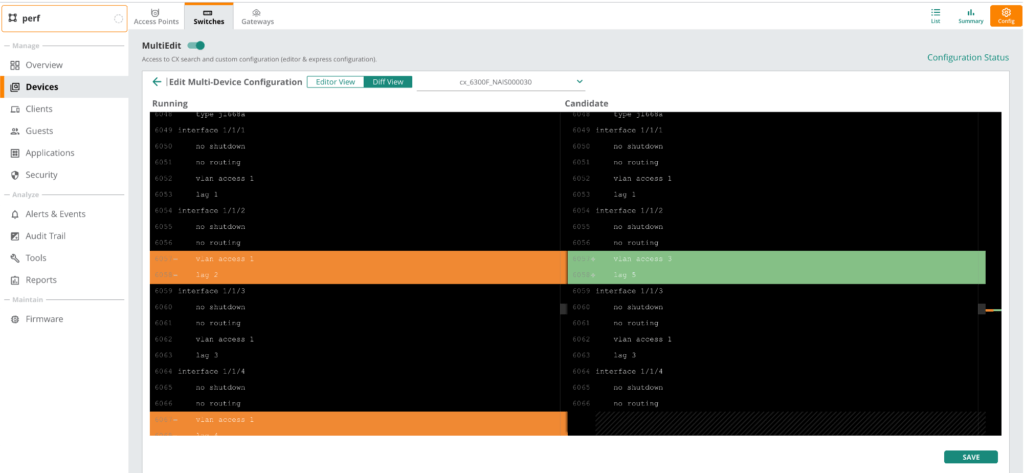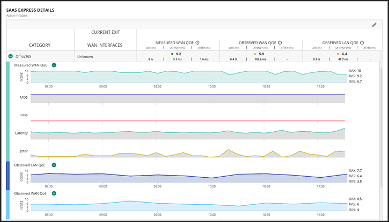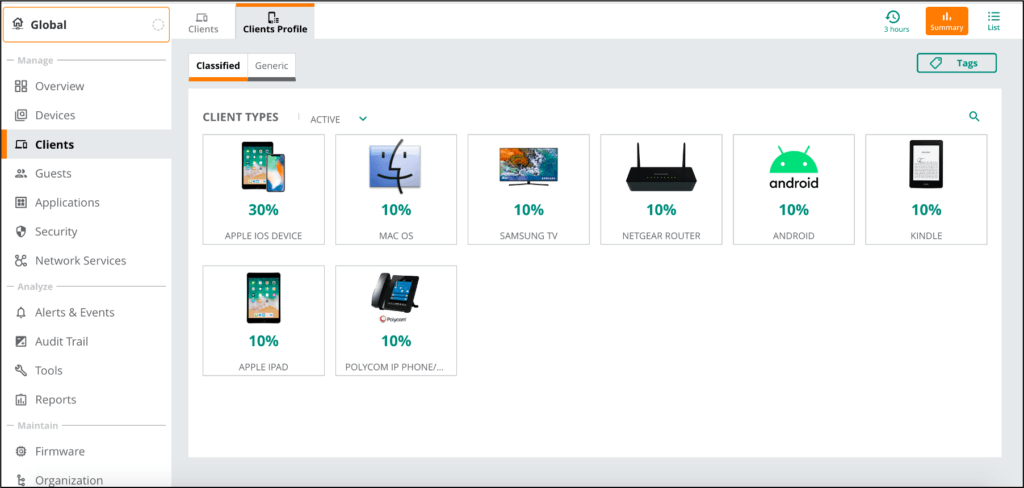
By all accounts, businesses have accelerated cloud adoption as a result of COVID-19. Last year, nearly three-fourths of companies reported increased spending on cloud1. The momentum has carried into 2021, as Gartner reports that overall cloud spending will increase by 18%2.
Increased adoption of cloud applications shines a light on another area of IT that could benefit from a cloud-driven approach – the network. With the latest release of Aruba Central, our cloud-based networking solution, we’re ready to help customers derive even more value from the cloud.
Let’s take a look at five networking trends shaping the modern edge-to-cloud era, and how Aruba Central can help you capitalize on them.
1. 50% of new network deployments will feature cloud management by 20223
The stat in the subhead above is from IDC, and Aruba’s survey with IT decision-makers from last summer surfaced a similar trend. As business travel and access to corporate offices remain restricted, IT needs the ability to remotely manage the network – at scale, and with ease. According to our survey, 83% of organizations report they will maintain, if not increase, their planned investments in cloud networking.
To better support the management of networks from the cloud, Aruba Central is introducing a number of innovative capabilities, including for our CX switching portfolio. Among these new management features are:
- A versatile multi-editor: Provides advanced configuration options for staging, validating, and pushing updates across multiple devices at once. The multi-editor includes the complete configuration file for every device and uses predictive assistance such as command completion, validation, and syntax highlighting. Admins can seamlessly toggle between the multi-edit mode and a powerful, yet simple UI config option to make more routine changes – no advanced networking skills required.
- Intelligent search: Search capabilities from Aruba NetEdit are now available in Aruba Central, enabling operators to use advanced queries to find a specific group of switches that meet certain criteria for maintenance, reporting, or compliance purposes.
- AI Insights: This release of Aruba Central also introduces a set of AI Insights for CX switches. With these insights, network admins can proactively surface and resolve issues such as excessive port flaps, PoE failures, and system performance problems using built-in, automated root cause analysis.
- Integration with NAE: In addition to these AI-powered insights, Aruba Central now pulls in telemetry from the on-board Aruba Network Analytics Engine (NAE) that runs natively on every CX switch.

Multi-editor for CX switches simplifies even the most complex of config changes
2. Only 6% of network teams characterize their automation efforts as being AIOps-driven4
Networks continue to grow, yet IT teams tasked with managing them are not. Given this resource gap, it’s not surprising that 77% of teams consider network automation to be a high priority5. At the same time, only 6% say their automation efforts are AIOps-driven. As a result, much of the network is still bound by human scale, and that includes troubleshooting user- or business-impacting issues.
Aruba Central and our AIOps solutions aim to change this by giving customers the actionable insights they need to proactively detect and resolve issues – or even avoid them altogether. Moreover, leveraging the common Aruba Central data lake can help them automatically surface trends that will help them continuously optimize network performance.
This release of Aruba Central delivers several AIOps enhancements including:
- Improved usability for AI Insights with enhanced filtering, one-click context into device- or user-impacting issues, and guided recommendations. This means even fewer clicks are required to troubleshoot and resolve issues.
- A more dynamic, AI-based search automatically surfaces recommendations and solution guides based on the user’s journey within Aruba Central. For instance, new customers will see recommendations for day 0-1 operations like, “How do I add devices to Central?” or “What are best practices for configuring CX switches?” Better yet, IT admins can launch diagnostics and troubleshooting tools such as live events or packet capture right from the search card result.
- AI Assist: AI Assist automatically collects diagnostics, triggers email alerts, and can even open up a support case with TAC or a ticket within popular incident management tools such as ServiceNow. The feature also intelligently rate-limits logs, automatically tying a maximum number of events to a particular issue within a given window. This makes logs more valuable and easier to use for monitoring and troubleshooting purposes.
3. 42% of businesses have adopted or are in the process of adopting SD-WAN6
Adoption of SD-WAN continues to grow at an impressive clip as businesses look to achieve higher return from cloud investments by delivering better economics, control, reliability, and performance.
For customers looking to extend beyond SD-WAN, Aruba SD-Branch addresses the entire branch user experience, delivering unified management, AIOps, and security for wired, wireless, and SD-WAN networking. As the orchestration engine for SD-Branch, Aruba Central delivers several new, critical capabilities to further simplify branch networking and operations, including:
- Branch mesh support: Customers can now enable a branch mesh topology with Aruba SD-Branch, enabling faster communication between remote locations without requiring the backhauling of traffic to a regional hub or data center. Branch mesh can lower routing costs and improve application performance due to the shorter paths traffic will take over the network. This is an allow-listed capability with this release.
- SaaS Express Enhancements: Customers can now send active probes or synthetic traffic across the network to proactively check for issues such as excessive jitter or packet loss. Active probes can be paired with passive monitoring techniques that observe the actual quality of service (QoS) for leading SaaS apps, thereby giving network and IT administrators a broader view into performance.
- Extending connectivity into IaaS: Customers can now spin up Aruba Virtual Gateways in Google Cloud Platform – adding to existing IaaS support for AWS and Microsoft Azure. With this capability, IT can seamlessly extend branch connectivity into public cloud environments, with full route orchestration and end-to-end visibility to better manage the performance of critical cloud services.
- Improved WAN visibility: Within the WAN monitoring tab of Aruba Central, IT administrators can now see performance statistics for all uplinks in one dashboard, and also gain quick visibility into the most widely used applications, further simplifying monitoring and troubleshooting activities across distributed business locations.

SaaS Express provides a broader view into application performance with passive and active monitoring techniques
4. Post-COVID, more than half of employees will work remotely at least part time7
Businesses continue to support an unprecedented number of teleworkers as a result of the pandemic. What’s become apparent is that the new normal is a hybrid workplace – one where employees operate from dedicated office spaces as well as from home offices. According to IDC, more than half of employees will work remotely full-time or have a hybrid arrangement after pandemic-related impacts subside.
According to that same IDC research report, 70% of businesses still have user-impacting performance issues daily or multiple times a week8. IT needs better visibility into these remote networks to ensure employees have more reliable access to business apps and data – no matter where they work.
The latest release of Aruba Central builds on our existing portfolio of hybrid workplace solutions with:
- AP Live Events: Similar to client live troubleshooting, this feature enables live events on access points for real-time analysis into wireless performance. This includes being able to debug IPsec tunnel establishment issues, radio-specific issues, and spectrum events in an on-demand fashion.
- Tunnel Alerts: Admins can also set up alerts within Aruba Central to proactively monitor the health and availability of VPN tunnels to notify IT of connectivity issues as they occur.
- Remote clients and VIA client monitoring: A new tab is available in the Central UI for remote clients, which shows connectivity per VIA client, what Gateway those devices are connecting to, and bandwidth usage, bringing more visibility into the user experience for at-home employees.
5. 80% of IT orgs report having IoT devices they did not install or secure9
Businesses are implementing an array of IoT-capable devices to make their operations more efficient, intelligent, and dynamic. However, such devices are often installed without IT’s involvement or knowledge. In a Gartner customer survey, 80% of IT organizations noted that they found IoT devices on their networks that they did not install, secure, or manage.
As much of 30% of undiscovered devices are deployed by other organizations, such as facility management teams. Gartner notes that these organizations typically want their devices on the network within 24 hours of making the request10. Given that IoT devices aren’t as inherently secure as other connected devices, this can be a major security risk.
Aruba Central and ClearPass Device Insight can eliminate this critical visibility gap for IT. ClearPass Device Insight, which delivers AI-based discovery and profiling of all connected devices, including IoT and mobile, is now natively integrated within Aruba Central.

AI-powered device profiling is now natively integrated with Aruba Central
What this means is that Central customers can now see summary and detailed views of all profiled clients that are connected to Aruba SD-Branch Gateways or Aruba Instant Access Points (IAPs). For IAPs, static attributes are collected, whereas both static and flow attributes are collected from Gateways. Customers can also create new authentication policies and tags based on the behavior of all profiled devices. What this all amounts to is better operational visibility and a more proactive security posture for IoT.
Embrace Cloud Networking with Aruba Central
As businesses continue to adapt to this new economic landscape, IT leaders require the agility, scale, and efficiency of the cloud more than ever before. Cloud-based solutions like Aruba Central can bring that level of adaptability and resilience to the network. Explore more of the latest cloud-delivered innovations we’re bringing into Aruba Central, or give it a test drive for your business today with a free trial.
-----
Sources:
- Gartner, “Gartner Forecasts Worldwide Public Cloud End-user Spending to Grow 18% in 2021,” Nov. 17, 2020
- Ibid
- IDC, Five Key Enterprise Networking Trends to Watch in 2020, April 2020
- EMA, Research Summary: Enterprise Network Automation for 2020 and Beyond,” 2019
- Ibid
- IDC, Five Key Enterprise Networking Trends to Watch in 2020, April 2020
- IDC, Future of Enterprise Networking: Emergence of the New Normal, Feb. 2021
- Ibid
- Gartner, “Segmentation or Isolation: Implementing Best Practices for Connecting ‘All’ Devices,” Sept. 26, 2019
- Ibid




